Abstract
A new quinolone, Win 57273 [1-cyclopropyl-7-(2,6-dimethyl-4-pyridinyl)-6-fluoro-1,4-dihydro-4-oxo-3 - quinolonecarboxylic acid], synthesized by Sterling Research Group, was tested in vitro against Mycobacterium tuberculosis and Mycobacterium avium strains. The broth-determined MICs of this agent ranged from 1.0 to 4.0 micrograms/ml for M. tuberculosis strains and from 0.25 to 8.0 micrograms/ml for M. avium strains. A distinctive feature of this agent, in comparison with ofloxacin and ciprofloxacin, is its substantially greater activity at the low pHs. For M. avium strains, the MICs of Win 57273 were 2.0 micrograms/ml or less for 54.5% of strains at pH 6.8 and 85.5% of strains at pH 5.0. Win 57273 was more active than ciprofloxacin against M. avium strains, and this difference was very substantial for all M. avium strains at pH 5.0. Taking into account that the predominant locations of these organisms in vivo are within the phagosomes and phagolysosomes of macrophages, i.e., in acidic environments at pH 5.0 or lower, the greater activity of Win 57273 at low pH makes this quinolone especially promising for M. avium infection. The bactericidal activity of Win 57273 for M. avium strains was the same as that of ciprofloxacin, with MBCs from 4.0 to 16.0 micrograms/ml.
Full text
PDF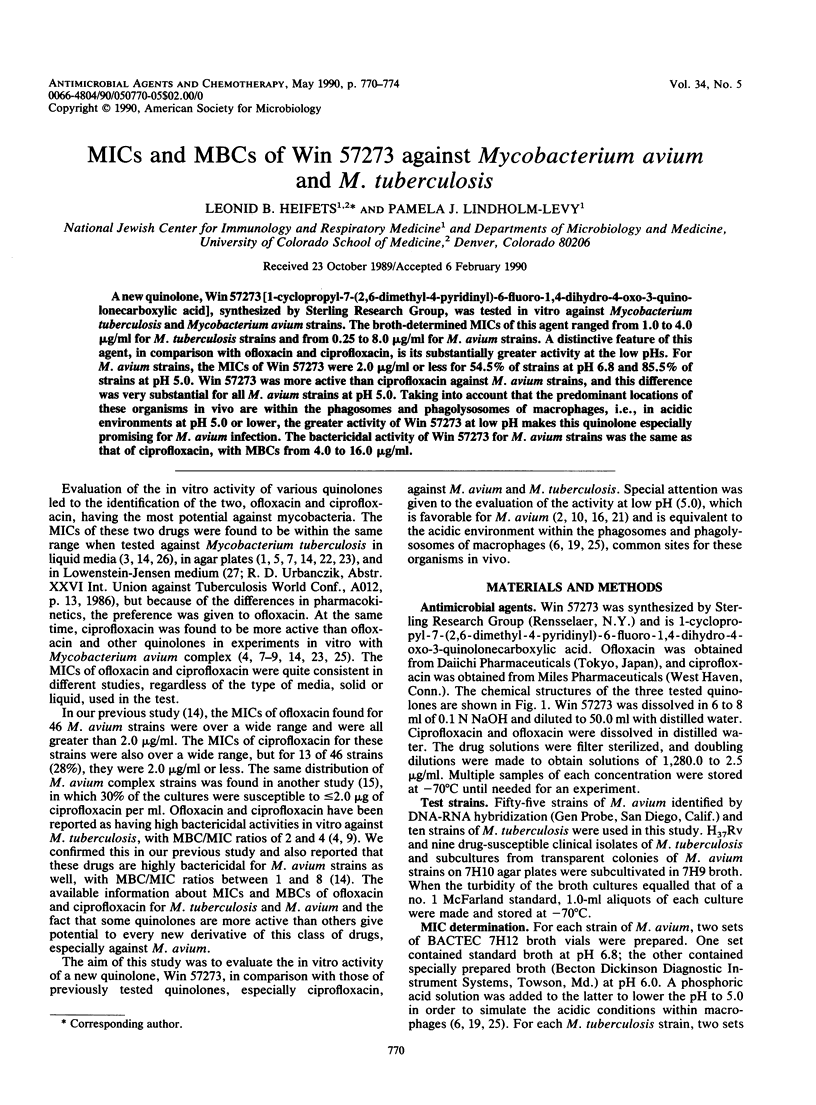
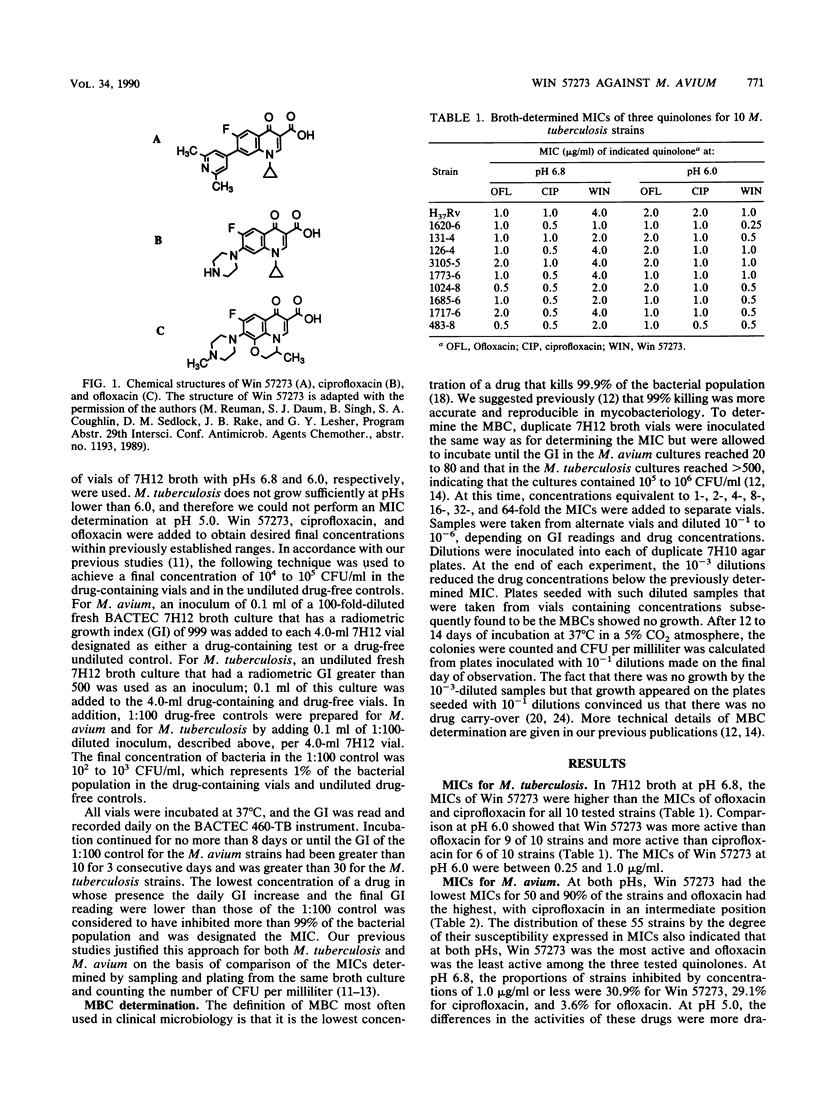
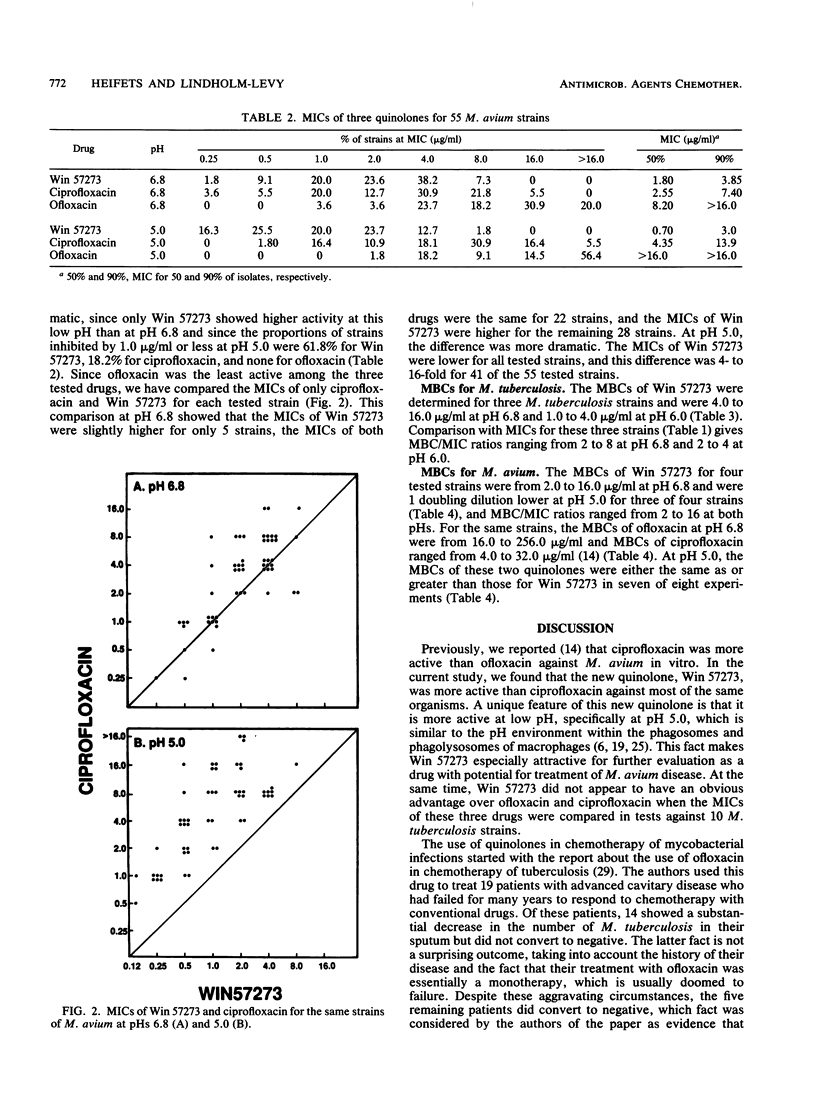
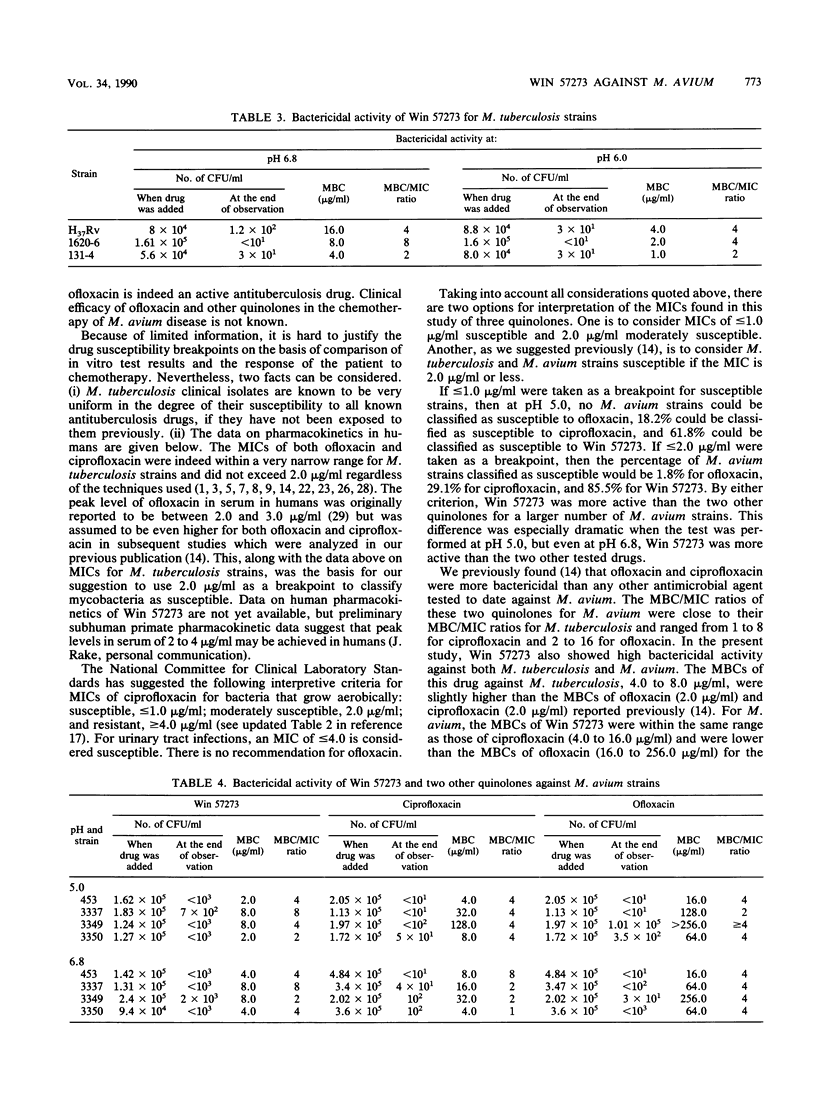
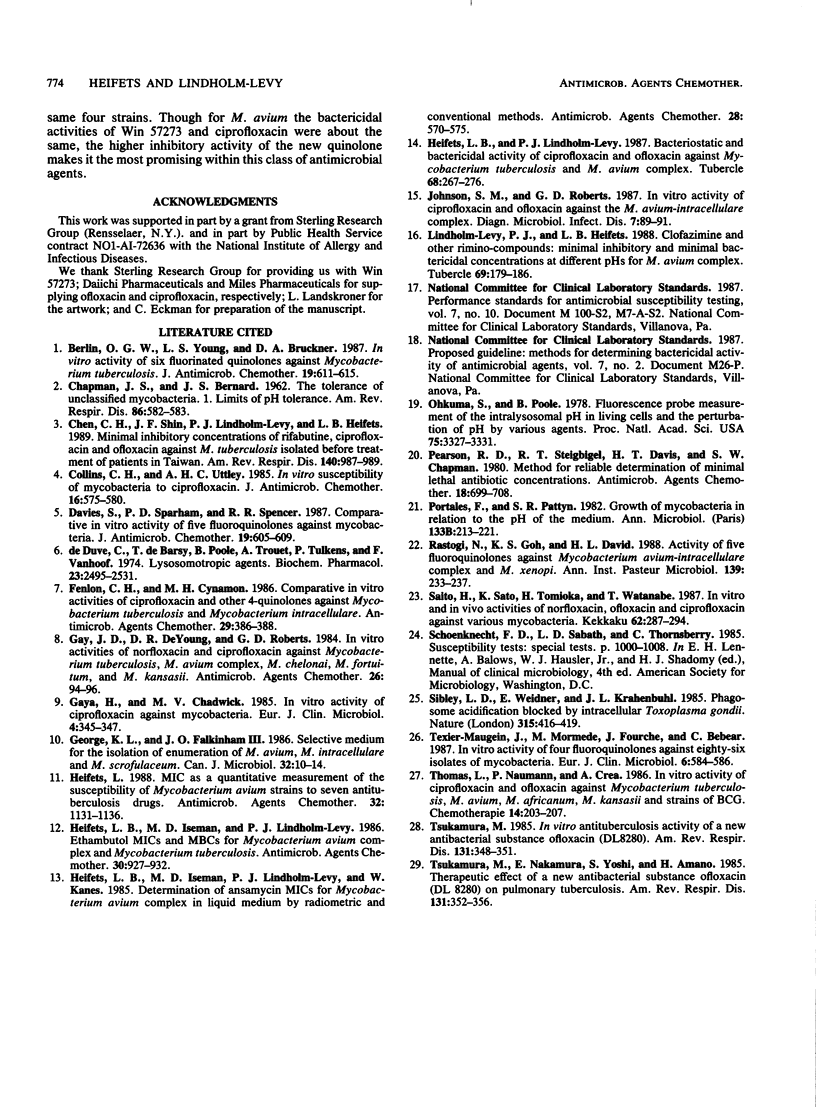
Selected References
These references are in PubMed. This may not be the complete list of references from this article.
- Berlin O. G., Young L. S., Bruckner D. A. In-vitro activity of six fluorinated quinolones against Mycobacterium tuberculosis. J Antimicrob Chemother. 1987 May;19(5):611–615. doi: 10.1093/jac/19.5.611. [DOI] [PubMed] [Google Scholar]
- CHAPMAN J. S., BERNARD J. S. The tolerances of unclassified mycobacteria. I. Limits of pH tolerance. Am Rev Respir Dis. 1962 Oct;86:582–583. doi: 10.1164/arrd.1962.86.4.582. [DOI] [PubMed] [Google Scholar]
- Chen C. H., Shih J. F., Lindholm-Levy P. J., Heifets L. B. Minimal inhibitory concentrations of rifabutin, ciprofloxacin, and ofloxacin against Mycobacterium tuberculosis isolated before treatment of patients in Taiwan. Am Rev Respir Dis. 1989 Oct;140(4):987–989. doi: 10.1164/ajrccm/140.4.987. [DOI] [PubMed] [Google Scholar]
- Collins C. H., Uttley A. H. In-vitro susceptibility of mycobacteria to ciprofloxacin. J Antimicrob Chemother. 1985 Nov;16(5):575–580. doi: 10.1093/jac/16.5.575. [DOI] [PubMed] [Google Scholar]
- Davies S., Sparham P. D., Spencer R. C. Comparative in-vitro activity of five fluoroquinolones against mycobacteria. J Antimicrob Chemother. 1987 May;19(5):605–609. doi: 10.1093/jac/19.5.605. [DOI] [PubMed] [Google Scholar]
- Fenlon C. H., Cynamon M. H. Comparative in vitro activities of ciprofloxacin and other 4-quinolones against Mycobacterium tuberculosis and Mycobacterium intracellulare. Antimicrob Agents Chemother. 1986 Mar;29(3):386–388. doi: 10.1128/aac.29.3.386. [DOI] [PMC free article] [PubMed] [Google Scholar]
- Gay J. D., DeYoung D. R., Roberts G. D. In vitro activities of norfloxacin and ciprofloxacin against Mycobacterium tuberculosis, M. avium complex, M. chelonei, M. fortuitum, and M. kansasii. Antimicrob Agents Chemother. 1984 Jul;26(1):94–96. doi: 10.1128/aac.26.1.94. [DOI] [PMC free article] [PubMed] [Google Scholar]
- Gaya H., Chadwick M. V. In vitro activity of ciprofloxacin against mycobacteria. Eur J Clin Microbiol. 1985 Jun;4(3):345–347. doi: 10.1007/BF02013668. [DOI] [PubMed] [Google Scholar]
- George K. L., Falkinham J. O., 3rd Selective medium for the isolation and enumeration of Mycobacterium avium-intracellulare and M. scrofulaceum. Can J Microbiol. 1986 Jan;32(1):10–14. doi: 10.1139/m86-003. [DOI] [PubMed] [Google Scholar]
- Heifets L. B., Iseman M. D., Lindholm-Levy P. J. Ethambutol MICs and MBCs for Mycobacterium avium complex and Mycobacterium tuberculosis. Antimicrob Agents Chemother. 1986 Dec;30(6):927–932. doi: 10.1128/aac.30.6.927. [DOI] [PMC free article] [PubMed] [Google Scholar]
- Heifets L. B., Iseman M. D., Lindholm-Levy P. J., Kanes W. Determination of ansamycin MICs for Mycobacterium avium complex in liquid medium by radiometric and conventional methods. Antimicrob Agents Chemother. 1985 Oct;28(4):570–575. doi: 10.1128/aac.28.4.570. [DOI] [PMC free article] [PubMed] [Google Scholar]
- Heifets L. B., Lindholm-Levy P. J. Bacteriostatic and bactericidal activity of ciprofloxacin and ofloxacin against Mycobacterium tuberculosis and Mycobacterium avium complex. Tubercle. 1987 Dec;68(4):267–276. doi: 10.1016/0041-3879(87)90067-5. [DOI] [PubMed] [Google Scholar]
- Heifets L. MIC as a quantitative measurement of the susceptibility of Mycobacterium avium strains to seven antituberculosis drugs. Antimicrob Agents Chemother. 1988 Aug;32(8):1131–1136. doi: 10.1128/aac.32.8.1131. [DOI] [PMC free article] [PubMed] [Google Scholar]
- Johnson S. M., Roberts G. D. In vitro activity of ciprofloxacin and ofloxacin against the Mycobacterium avium-intracellulare complex. Diagn Microbiol Infect Dis. 1987 May;7(1):89–91. doi: 10.1016/0732-8893(87)90077-0. [DOI] [PubMed] [Google Scholar]
- Lindholm-Levy P. J., Heifets L. B. Clofazimine and other rimino-compounds: minimal inhibitory and minimal bactericidal concentrations at different pHs for Mycobacterium avium complex. Tubercle. 1988 Sep;69(3):179–186. doi: 10.1016/0041-3879(88)90019-0. [DOI] [PubMed] [Google Scholar]
- Ohkuma S., Poole B. Fluorescence probe measurement of the intralysosomal pH in living cells and the perturbation of pH by various agents. Proc Natl Acad Sci U S A. 1978 Jul;75(7):3327–3331. doi: 10.1073/pnas.75.7.3327. [DOI] [PMC free article] [PubMed] [Google Scholar]
- Pearson R. D., Steigbigel R. T., Davis H. T., Chapman S. W. Method of reliable determination of minimal lethal antibiotic concentrations. Antimicrob Agents Chemother. 1980 Nov;18(5):699–708. doi: 10.1128/aac.18.5.699. [DOI] [PMC free article] [PubMed] [Google Scholar]
- Portaels F., Pattyn S. R. Growth of mycobacteria in relation to the pH of the medium. Ann Microbiol (Paris) 1982 Sep-Oct;133(2):213–221. [PubMed] [Google Scholar]
- Rastogi N., Goh K. S., David H. L. Activity of five fluoroquinolones against Mycobacterium avium-intracellulare complex and M. xenopi. Ann Inst Pasteur Microbiol. 1988 Mar-Apr;139(2):233–237. doi: 10.1016/0769-2609(88)90008-7. [DOI] [PubMed] [Google Scholar]
- Saito H., Sato K., Tomioka H., Watanabe T. [In vitro and in vivo activities of norfloxacin, ofloxacin and ciprofloxacin against various mycobacteria]. Kekkaku. 1987 May;62(5):287–294. [PubMed] [Google Scholar]
- Sibley L. D., Weidner E., Krahenbuhl J. L. Phagosome acidification blocked by intracellular Toxoplasma gondii. 1985 May 30-Jun 5Nature. 315(6018):416–419. doi: 10.1038/315416a0. [DOI] [PubMed] [Google Scholar]
- Texier-Maugein J., Mormède M., Fourche J., Bébéar C. In vitro activity of four fluoroquinolones against eighty-six isolates of mycobacteria. Eur J Clin Microbiol. 1987 Oct;6(5):584–586. doi: 10.1007/BF02014255. [DOI] [PubMed] [Google Scholar]
- Thomas L., Naumann P., Crea A. In-vitro-Aktivität von Ciprofloxacin und Ofloxacin gegen Mycobacterium tuberculosis, M. avium, M. africanum, M. kansasii und BCG-Stämme. Immun Infekt. 1986 Nov;14(6):203–207. [PubMed] [Google Scholar]
- Tsukamura M. In vitro antituberculosis activity of a new antibacterial substance ofloxacin (DL8280). Am Rev Respir Dis. 1985 Mar;131(3):348–351. doi: 10.1164/arrd.1985.131.3.348. [DOI] [PubMed] [Google Scholar]
- Tsukamura M., Nakamura E., Yoshii S., Amano H. Therapeutic effect of a new antibacterial substance ofloxacin (DL8280) on pulmonary tuberculosis. Am Rev Respir Dis. 1985 Mar;131(3):352–356. doi: 10.1164/arrd.1985.131.3.352. [DOI] [PubMed] [Google Scholar]
- de Duve C., de Barsy T., Poole B., Trouet A., Tulkens P., Van Hoof F. Commentary. Lysosomotropic agents. Biochem Pharmacol. 1974 Sep 15;23(18):2495–2531. doi: 10.1016/0006-2952(74)90174-9. [DOI] [PubMed] [Google Scholar]


